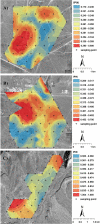The impacts of mining on soil pollution with metal(loid)s in resource-rich Mongolia
- PMID: 36797312
- PMCID: PMC9935523
- DOI: 10.1038/s41598-023-29370-w
The impacts of mining on soil pollution with metal(loid)s in resource-rich Mongolia
Abstract
As Mongolia is considered one of the most resource extraction-dependent countries globally, significant mining-related environmental and human health risks are expected. The aim of this study was to (I) assess the impacts of mining on soil pollution with metals in Mongolia's key coal mining towns (Baganuur, Nalaikh and Sharyn Gol) and (II) review the current knowledge on soil pollution with metal(loid)s and related health risks in Mongolia. The results showed predominantly low soil contents of Cd, Cu, Pb and Zn and a related absence of severe pollution and potential health risk in the coal mining towns. Urban design, rather than the presence of mines, controlled the pollution distribution. Despite the methodological shortcomings of several studies on soil pollution in Mongolia, their results suggest a similarly low threat in the three largest cities (Ulaanbaatar, Darkhan, Erdenet) and several mining areas. While the generally highlighted risk of As seems like an artificially escalated issue, the content of Cr in urban soil may be a neglected threat. Further pollution research in Mongolia should focus on street dust and drinking water pollution.
© 2023. The Author(s).
Conflict of interest statement
The authors declare no competing interests.
Figures



Similar articles
-
Contamination and Health Risk Assessment of Heavy Metals in the Soil of Major Cities in Mongolia.Int J Environ Res Public Health. 2019 Jul 17;16(14):2552. doi: 10.3390/ijerph16142552. Int J Environ Res Public Health. 2019. PMID: 31319540 Free PMC article.
-
The spatial distribution and accumulation characteristics of heavy metals in steppe soils around three mining areas in Xilinhot in Inner Mongolia, China.Environ Sci Pollut Res Int. 2017 Nov;24(32):25416-25430. doi: 10.1007/s11356-017-0113-0. Epub 2017 Sep 20. Environ Sci Pollut Res Int. 2017. PMID: 28932981
-
Investigating Heavy Metal Pollution in Mining Brownfield and Its Policy Implications: A Case Study of the Bayan Obo Rare Earth Mine, Inner Mongolia, China.Environ Manage. 2016 Apr;57(4):879-93. doi: 10.1007/s00267-016-0658-6. Epub 2016 Jan 20. Environ Manage. 2016. PMID: 26787014
-
A global meta-analysis of heavy metal(loid)s pollution in soils near copper mines: Evaluation of pollution level and probabilistic health risks.Sci Total Environ. 2022 Aug 20;835:155441. doi: 10.1016/j.scitotenv.2022.155441. Epub 2022 Apr 22. Sci Total Environ. 2022. PMID: 35469881 Review.
-
A review of soil heavy metal pollution from mines in China: pollution and health risk assessment.Sci Total Environ. 2014 Jan 15;468-469:843-53. doi: 10.1016/j.scitotenv.2013.08.090. Epub 2013 Sep 25. Sci Total Environ. 2014. PMID: 24076505 Review.
Cited by
-
Effect of Lyoprotective Agents on the Preservation of Survival of a Bacillus cereus Strain PBG in the Freeze-Drying Process.Microorganisms. 2023 Nov 4;11(11):2705. doi: 10.3390/microorganisms11112705. Microorganisms. 2023. PMID: 38004717 Free PMC article.
-
Blowin' in the Wind: Mapping the Dispersion of Metal(loid)s From Atacama Mining.Geohealth. 2024 Oct 1;8(10):e2024GH001078. doi: 10.1029/2024GH001078. eCollection 2024 Oct. Geohealth. 2024. PMID: 39355274 Free PMC article.
-
Health and ecological risk of heavy metals in agricultural soils related to Tungsten mining in Southern Jiangxi Province, China.PeerJ. 2024 Apr 1;12:e17200. doi: 10.7717/peerj.17200. eCollection 2024. PeerJ. 2024. PMID: 38577416 Free PMC article.
References
-
- MRPAM, The annual report 2016: Geology, mining, petroleum, heavy industry. Mineral Resources and Petroleum Authority of Mongolia (MRPAM), Ulaanbaatar. https://www.mrpam.gov.mn/public/pages/66/MPRAMreport2016EN.pdf (2017).
-
- UNDP, About Mongolia. United Nations Development Programme (UNDP). https://www.mn.undp.org/content/mongolia/en/home/countryinfo/ (2022), Accessed 10 December 2021.
Grants and funding
LinkOut - more resources
Full Text Sources
Research Materials

